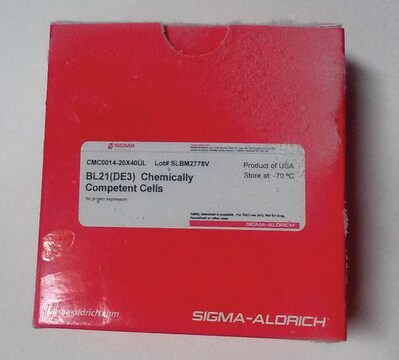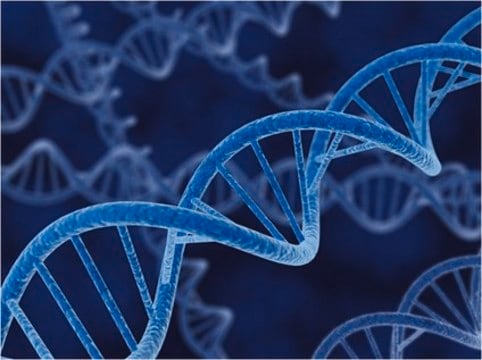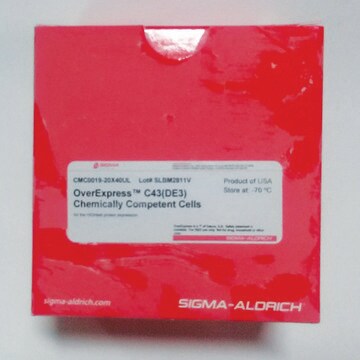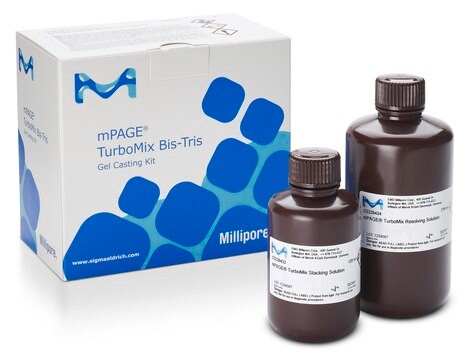추천 제품
product name
BL21(DE3) Chemically Competent Cells, for protein expression
생물학적 소스
Escherichia coli
Grade
for molecular biology
성장 모드
adherent or suspension
형태학
rod shaped
기술
microbiological culture: suitable
세포 형질전환
competent cell type: chemically competent
transformation efficiency: ≥1 x 107 cfu/μg
배송 상태
dry ice
저장 온도
−70°C
일반 설명
The BL21(DE3) Chemically Competent strains contain the phage T7 RNA polymerase gene linked to the IPTG-inducible promoter, for use with any expression plasmid containing the T7 promoter.
Genotype
F – ompT hsdSB (rB- mB-) gal dcm (DE3)
Genotype
F – ompT hsdSB (rB- mB-) gal dcm (DE3)
애플리케이션
The E. coli strain BL21 (DE3) has been used:
- to express tau 2N4R isoform (aa1–441) and the truncated tau (aa1–421) using pET19b as expression vector.
- BL21(DE3)Chemically Competent Cells has been used for the transformation and expressionof protegrin-1 (PG1) peptides.
- to express 6His-TEVsite-Hs ARF1 (17-181)-Q71L in pHis2 vector.
특징 및 장점
- a transformation efficiency of >1 × 107 cfu/μg.
- economical prices
- offering superior value for everyday protein expression work.
성분
- BL21(DE3) chemically competent cells
- pUC 19 transformation control DNA
- recovery medium for expression
관련 제품
제품 번호
설명
가격
Storage Class Code
10 - Combustible liquids
시험 성적서(COA)
제품의 로트/배치 번호를 입력하여 시험 성적서(COA)을 검색하십시오. 로트 및 배치 번호는 제품 라벨에 있는 ‘로트’ 또는 ‘배치’라는 용어 뒤에서 찾을 수 있습니다.
Yasaman Damestani et al.
Lasers in surgery and medicine, 48(8), 782-789 (2016-10-19)
The development and feasibility of a novel nanocrystalline yttria-stabilized-zirconia (nc-YSZ) cranial implant has been recently established. The purpose of what we now call "window to the brain (WttB)" implant (or platform), is to improve patient care by providing a technique
A validated antibody panel for the characterization of tau post-translational modifications.
Ebru E, et al.
Mol. Neurodegener., 12(1), 87-87 (2017)
Romana Koszagova et al.
Microbial cell factories, 17(1), 139-139 (2018-09-05)
Physiological aggregation of a recombinant enzyme into enzymatically active inclusion bodies could be an excellent strategy to obtain immobilized enzymes for industrial biotransformation processes. However, it is not convenient to recycle "gelatinous masses" of protein inclusion bodies from one reaction
David B Sauer et al.
eLife, 9 (2020-09-02)
Citrate, α-ketoglutarate and succinate are TCA cycle intermediates that also play essential roles in metabolic signaling and cellular regulation. These di- and tricarboxylates are imported into the cell by the divalent anion sodium symporter (DASS) family of plasma membrane transporters
Gints Kalnins et al.
Nature communications, 11(1), 388-388 (2020-01-22)
Bacterial microcompartments (BMCs) are prokaryotic organelles consisting of a protein shell and an encapsulated enzymatic core. BMCs are involved in several biochemical processes, such as choline, glycerol and ethanolamine degradation and carbon fixation. Since non-native enzymes can also be encapsulated
관련 콘텐츠
BL21 Chemically Competent Cells are provided in aliquots of 80 μL sufficient for two transformation reactions of 40 μL each. Transformation is performed by heat shock at 42 °C, followed by incubation on ice.
자사의 과학자팀은 생명 과학, 재료 과학, 화학 합성, 크로마토그래피, 분석 및 기타 많은 영역을 포함한 모든 과학 분야에 경험이 있습니다..
고객지원팀으로 연락바랍니다.







